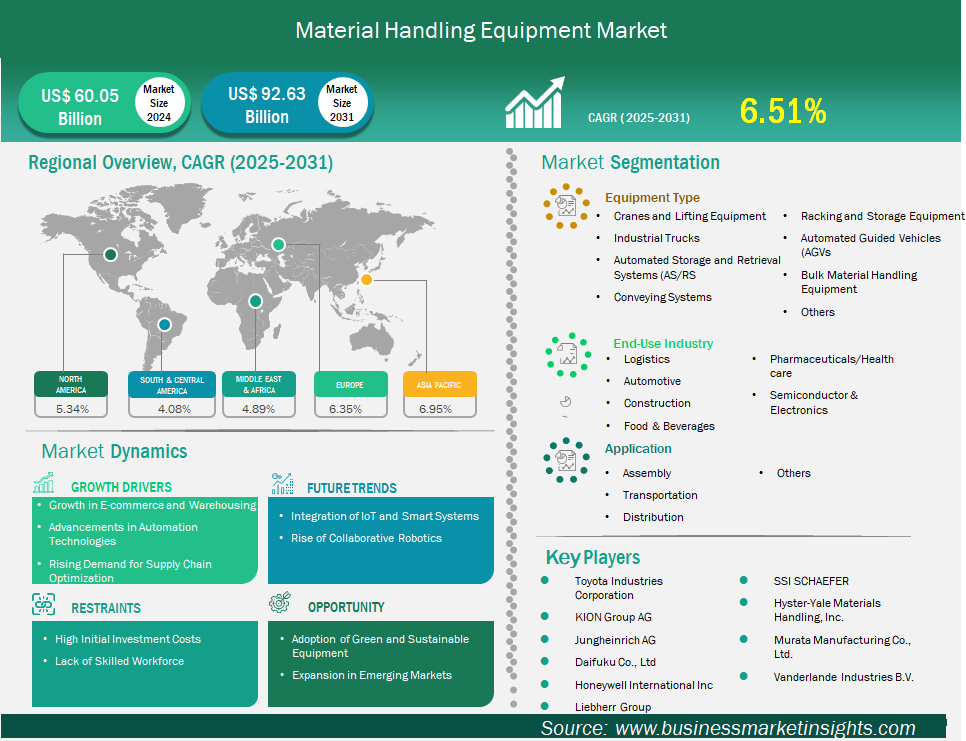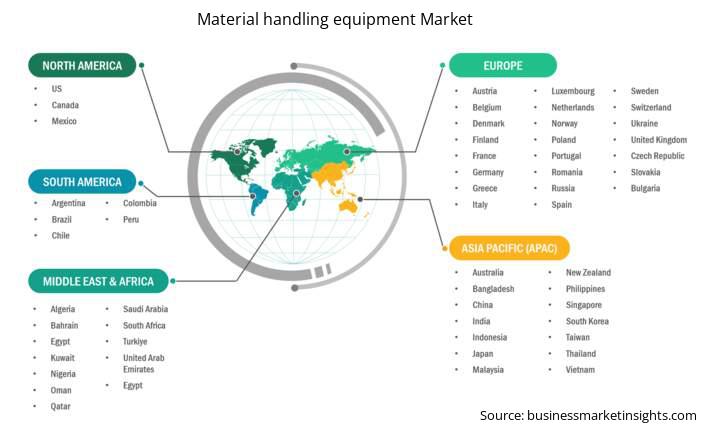Material Handling Equipment Market Outlook (2021-2031)
No. of Pages: 200 | Report Code: BMIPUB00031690 | Category: Automotive and Transportation
No. of Pages: 200 | Report Code: BMIPUB00031690 | Category: Automotive and Transportation
The Material handling equipment market size is expected to reach US$ 92.63 billion by 2031 from US$ 60.05 billion in 2024. The market is estimated to record a CAGR of 6.51% from 2025 to 2031.
The global material handling equipment market is experiencing robust growth driven by rapid industrialization, warehouse automation, and the expanding e-commerce sector. This market encompasses a diverse range of equipment designed to transport, store, control, and protect materials throughout manufacturing, distribution, and disposal processes. The industry's expansion is primarily fueled by increasing demand for operational efficiency, growing adoption of automation technologies, and the need for enhanced supply chain transparency. Material handling equipment manufacturers are responding to these market dynamics by developing innovative solutions that integrate advanced technologies such as artificial intelligence, Internet of Things (IoT), and robotics to optimize warehouse operations and logistics infrastructure. The market demonstrates strong regional variations, with Asia-Pacific maintaining leadership due to extensive infrastructure investments and rapid urbanization across countries like China and India.
The material handling equipment market is being shaped by several key drivers, including the rapid expansion of e-commerce operations, increasing warehouse automation, and growing emphasis on operational efficiency. The integration of Industry 4.0 technologies into warehouse management facilities and logistics infrastructure has created a more dynamic and competitive landscape. Labour shortages and warehouse disruptions, particularly following the pandemic, have accelerated investments in robotics and IoT-enabled systems, highlighting the critical need for automated solutions. The rise of same-day delivery models and last-mile delivery growth has fundamentally transformed industrial and logistical operations globally, creating sustained demand for sophisticated material handling systems. Additionally, government initiatives promoting infrastructure development and manufacturing sector growth are providing significant impetus to market expansion across various regions.

Key segments that contributed to the derivation of the Material handling equipment market analysis are technology, material, application, and end user.
The rapid expansion of e-commerce is a major driver for the material handling equipment market. With increasing online retail, companies like Amazon and Alibaba are investing in automated warehouses to manage high order volumes. This boosts demand for forklifts, conveyors, and automated guided vehicles (AGVs). Urbanization and rising consumer expectations for fast delivery further fuel the need for efficient logistics systems. Warehousing growth in regions like Asia-Pacific and North America drives equipment sales. As e-commerce continues to grow, the demand for advanced material handling solutions to streamline operations and reduce delivery times will significantly propel market expansion.
Technological advancements in automation are driving the material handling equipment market. Innovations like robotics, AI, and IoT enable the development of smart equipment such as automated storage and retrieval systems (AS/RS) and robotic arms. These technologies enhance efficiency, reduce labor costs, and improve accuracy in material handling processes. Industries like manufacturing and logistics are adopting automated solutions to meet rising production demands and optimize supply chains. Additionally, advancements in sensor technology and machine learning enable real-time inventory tracking and predictive maintenance. As automation becomes more accessible, its adoption will continue to accelerate market growth across various sectors.
By equipment type, Cranes and Lifting Equipment, Industrial Trucks, Automated Storage and Retrieval Systems (AS/RS), Conveying Systems, Racking and Storage Equipment, Automated Guided Vehicles (AGVs), Bulk Material handling equipment, Others – Cranes and lifting equipment are essential in construction, manufacturing, heavy engineering, automotive, and logistics sectors for efficiently transferring heavy materials and payloads. The construction industry, in particular, drives significant demand due to urbanization, infrastructure development, and large-scale industrial projects.
By end-user industry, The global expansion of automobile production stimulates the need for efficient material handling systems to manage the flow of materials and finished vehicles within factories and distribution centres. Automotive manufacturing plants increasingly implement modernized material handling infrastructure to improve assembly processes, reduce turnaround times, and support lean manufacturing principles, all of which require advanced handling equipment. The automotive industry's adoption of automation, robotics, and IoT-enabled material handling solutions enhances operational efficiency and safety, further boosting demand for sophisticated equipment.
By application, Transportation is a fundamental operation in material handling, involving the movement of materials from one location to another within manufacturing plants, warehouses, and distribution centers, which is critical for efficient supply chain and production workflows.
By geography, the material handling equipment market is experiencing robust but regionally varied growth, shaped by economic development, urbanization, government policies, and evolving consumer preferences. Asia Pacific is the largest and fastest-growing material handling equipment market, led by China, India, and Japan. Southeast Asian countries like Indonesia, Vietnam, and the Philippines are also witnessing surges in demand due to rising incomes and urbanization.
Material Handling Equipment Market Report Highlights
Report Attribute
Details
Market size in 2024
US$ 60.05 Billion
Market Size by 2031
US$ 92.63 Billion
Global CAGR (2025 - 2031) 6.51%
Historical Data
2021-2023
Forecast period
2025-2031
Segments Covered
By Equipment Type
By End-Use Industry
By Application
Regions and Countries Covered
North America
Europe
Asia-Pacific
South and Central America
Middle East and Africa
Market leaders and key company profiles
The "Material handling equipment Market Size and Forecast (2021–2031)" report provides a detailed analysis of the market covering below areas:

The geographical scope of the material handling equipment market report is divided into five regions: North America, Asia Pacific, Europe, Middle East & Africa, and South & Central America. The Material handling equipment market in Asia Pacific is expected to grow significantly during the forecast period.
The Asia-Pacific region currently dominates the global material handling equipment market, holding the largest market share among all regions. Asia Pacific, led by countries such as China, India, and Japan, has a well-established and rapidly expanding manufacturing base, including automotive, electronics, battery production, and heavy industries, which are major consumers of material handling equipment. Countries like Japan and China are leaders in integrating robotics, AI, and IoT into material handling systems, including automated storage and retrieval systems (AS/RS), automated guided vehicles (AGVs), and smart conveyor systems, enhancing operational efficiency and safety.
Programs such as China’s 'Belt and Road' initiative and India’s "Make in India" campaign support industrial modernization, logistics infrastructure development, and automation adoption, further boosting market growth. China remains the world’s largest manufacturer, with significant foreign investment and a strong push towards smart factories and warehouse automation, making it a central driver of the region’s market share.
The Material handling equipment market is evaluated by gathering qualitative and quantitative data post primary and secondary research, which includes important corporate publications, association data, and databases. A few of the key developments in the Material handling equipment market are:
The Material Handling Equipment Market is valued at US$ 60.05 Billion in 2024, it is projected to reach US$ 92.63 Billion by 2031.
As per our report Material Handling Equipment Market, the market size is valued at US$ 60.05 Billion in 2024, projecting it to reach US$ 92.63 Billion by 2031. This translates to a CAGR of approximately 6.51% during the forecast period.
The Material Handling Equipment Market report typically cover these key segments-
The historic period, base year, and forecast period can vary slightly depending on the specific market research report. However, for the Material Handling Equipment Market report:
The Material Handling Equipment Market is populated by several key players, each contributing to its growth and innovation. Some of the major players include:
The Material Handling Equipment Market report is valuable for diverse stakeholders, including:
Essentially, anyone involved in or considering involvement in the Material Handling Equipment Market value chain can benefit from the information contained in a comprehensive market report.